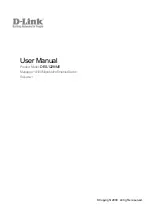
189
6620-3201
4.80 Confi gure
>
TPAD
>
TPAD Statistics
There are a number of statistics generated when TPAD transactions are received by the unit. This
web page allows you to con
fi
gure how those statistics are generated and used.
Using the Web Page(s)
Number of most recent transaction times to average:
This parameter speci
fi
es the number of most recent transaction times to average. This average value
is maintained in a separate statistic shown on the
Statistics
>
TPAD
>
TPAD n
web pages.
Generate event after this many consecutive failures:
This parameter speci
fi
es the total number of consecutive failures before a system event is generated.
Failures may be L3, L2, L1 or host response failures.
Generate event after average transaction time exceeds (ms):
This parameter speci
fi
es that a system event will be generated if the average transaction time for the
last “n” events (“n” is set by
Number of most recent transaction times to average
) exceeds this
time (in milliseconds).
4.81 Confi gure
>
TPAD
>
TPAD n
TPAD is a simpli
fi
ed version of the X.25 PAD speci
fi
cation that is commonly used for carrying out
credit-card clearance transactions. Westermo units support the use of TPAD over the ISDN B and
D channels and also over an IP interface such as GPRS via XOT or TCP. Automatic back-up between
any two of these “layer 2 interfaces” is supported.
For further information on using TPAD please refer to the application note “AN4 - Implementing TPAD”
available for download in the “Download” section of the Westermo web site (
www.Westermo.co.uk
).
Using the Web Page(s)
The
Confi gure
>
TPAD
folder expands to list separate pages for each of the available TPAD
instances. Each page is split into two sections. The
fi
rst section includes general TPAD parameters
(many of which are common to X.25 PADS). The second includes parameters relating to the backup
interface.
B-channel #:
This parameter may be used to specify an ISDN number. This is used in cases where no ISDN
number is provided with the ATD command when making an outgoing call.
Prefi x #:
This parameter is used to specify a dialling code that the unit will place in front of the telephone
number that is issued by the terminal in the ATD command. For example, if the Pre
fi
x # was set to
0808 and the number speci
fi
ed by the terminal in the ATD command was 111222, the actual number
dialled by the unit would be 0808111222.
Prefi x removal #:
This parameter is used to specify a dialling pre
fi
x that is normally inserted by the terminal in the ATD
command that is removed by the unit before dialling takes place. For example, if the Pre
fi
x removal
# was set to 0808 and the terminal issued an ATD command containing 0808111222 then the actual
number dialled by the unit would be 111222.
Note:
Pre
fi
x # and Pre
fi
x removal # are usually used in conjunction with each other to substitute the dialling
code issued by the terminal for an alternative code.
Suffi x #:
The Suf
fi
x # parameter may be set to contain additional numbers that are dialled after the number
speci
fi
ed by
B-channel #
. For example, if
B-channel #
was set to 123456 and Suf
fi
x # was set to
789, the actual number dialled would be 123456789.
















































